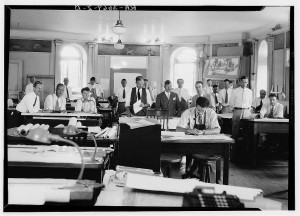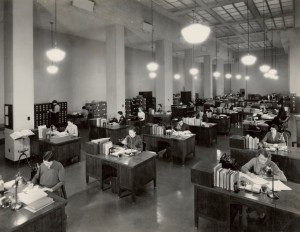Caption: An architect’s office in the 1940s
If there’s one topic that inflames debate, it’s the open plan office. They can be noisy, distracting and bad for our health – so why, after nearly 100 years of being unable to escape our co-workers, are we still pretending they’re a good idea?
The first modern office was the Larkin Administration Building, which was opened in 1906 in New York. The building was designed by Frank Lloyd Wright and was based on an open-plan factory, with very few walls.
Since then, the popularity of the open plan office has gone from strength to strength, with millions of us now working elbow to elbow with our colleagues. The layout is intended to promote collaboration and social interaction, a working style supposedly favoured by the current occupants of UK offices, Generation Y, according to an article by Dr Michael O’Neill on Metropolismag.com.
And yet a quick internet search for ‘open plan offices’ returns almost nothing but criticism, with numerous studies finding that the layout makes us miserable, distracted and less productive.
So, what’s going on?
Caption: Division of Classification and Cataloguing, November 17, 1937
The open plan office was first designed in the early 1900s
Open plan offices exist first and foremost to promote easy communication between teams. However, the first designs in the early 1900s were very different to what we know now, with clerical workers sat in neat rows facing forwards – like a classroom without a teacher.
It was in the early 1960s that the more recognisable organic layout caught the attention of designers. The concept was created by the consultants, Quickborner, and was called Burolandschaft or office landscaping. It featured what appeared to be a higgledy-piggledy layout of scattered desks, which were clustered in work groups of different sizes.
The design was in fact anything but random. According to a leading exponent of Burolandschaft, Frank Duffy, “The layout was based upon an intensive study of patterns of communication – between different parts of the organisation, different individuals.”
This new type of office plan was deliberately organised to encourage disclosure, discussion and debate.
Caption: The open plan BBC news room – one of the most scrutinised offices in the world
Open plan layouts have grown in popularity in recent years
In recent years, the open plan office has experienced a massive boost in popularity, thanks to the trend for more flexible layouts, with open spaces that foster informality and an interactive group dynamic.
This popularity can in part be attributed to the layout’s adoption by numerous high-profile companies – for example the BBC’s open plan newsroom is one of the most scrutinised offices in the world, appearing on our television screens night after night.
Other adherents to the open plan layout include Google, Yahoo, eBay and Facebook, who commissioned world-famous architect, Frank Gehry, to create an office with the “largest open floor plan in the world”.
The popularity of this type of design is also motivated by a belief that Generation Y – the generation that currently makes up the majority of the workforce – are motivated by collaboration and the need for social connection.
However, Gen Y also demands choice over the location of their work and an option of spaces to use. Therefore, a truly modern office cannot just have an open plan layout – it must offer workers a number of flexible spaces and allow them to choose which will work best for the task at hand.
In a survey, 95% of workers said working privately was important to them
When it comes to offices where the only option is to work in an open plan environment, the latest and historic research is overwhelmingly negative.
For example, extensive international research from Ipsos and the Workspace Futures Team of Steelcase recently found that 85% of people are dissatisfied with their workspace and can’t concentrate; with 95% of those surveyed saying that working privately was important to them.
It was also found that office workers lose 86 minutes a day to distractions – a statistic which is less surprising when you consider the noise and chatter which fills the modern office.
A number of other prominent researchers have arrived at similar conclusions when it comes to open plan office layouts:
- Dr Vinesh Oommen concluded in a literature review that, “In 90 per cent of the research, the outcome of working in an open plan office was seen as negative, with open plan offices causing high levels of stress, conflict, high blood pressure, and a high staff turnover.” (source: Forbes)
- A 2013 study found that workers in open plan environments are frustrated by distractions, which leads to poor performance. (source: Science Direct)
- A longitudinal field study found that employees who moved to an open plan office were less satisfied with factors such as physical environment and co-worker relations. (source: Sage Journals)
In fact, the only positives in favour of the open plan office seem to be more spontaneous interactions, transparency and camaraderie building – however, experts who have studied the subject argue that the conversations that occur are superficial, due to the fact that people are self-conscious about being overheard.
The answer is choice of environment
The most realistic solution to the problem seems to be choice. Research suggests that autonomy is the key, with employees performing better when they can control their environment.
Whilst it’s not possible to provide every worker with multiple desks in different areas, it is possible to provide a number of different environments, which the workforce can shift around in – a setup known as “hot desking”. For example, the new BBC offices have 3,500 workstations for 5,600 staff, with the idea being that shift patterns will allow for sharing.
Another solution is truly flexible workplace design, utilising features such as easily re-locatable partitioning and furniture. For example, at Facebook’s headquarters, employees have the ability to tailor the layout, height and configuration of their desks to suit their personal preference. Different teams can also create workspaces to suit the project they’re working on, as well as having a choice of a vast array of meeting spaces.
The ability to create and control their entire day in accordance with the needs of work, results in employees being entirely in control of their own productivity and time management – something which has been shown to lead to greater organisational productivity.
Despite the negative criticism the open plan office layout has received over the last 100 years, it still remains a staple part of our working environment. The solution – which appears to be increasingly adopted by businesses – is choice, with employees able to re-configure their own environment or able to choose from a variety of different environments.
What’s your opinion of the open plan office and what would be your solution to the problem?
Image one by Wikimedia
Image two by Wikimedia
Image three by mathewingram





